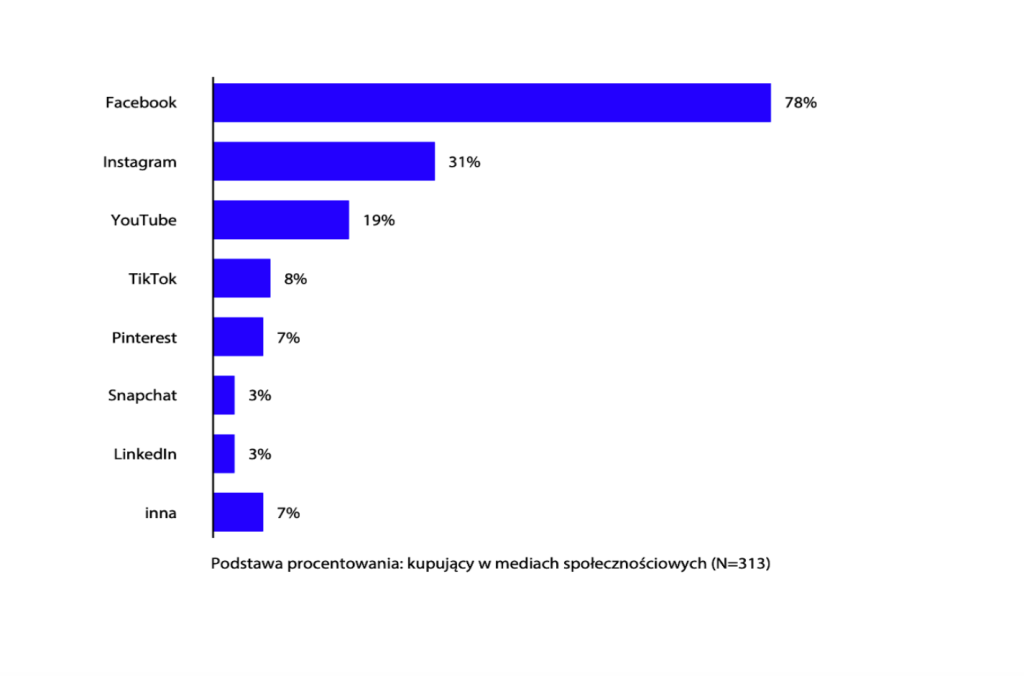-
Image and Sales on Social Media – What You Need to Know
46% of online purchases in Poland are made through social media, with 26% of them taking place on Facebook. This is the highest result among the European countries surveyed [1].
These figures are a strong reason for your brand to be present on social media! However, simply “being” there is not enough. Actions should be based on a strategy: they should stem from the core communication idea, be tailored to specific audiences, and remain consistent with activities across other channels.
Brands like IKEA do this exceptionally well, seamlessly combining Real-Time Marketing with a humorous presentation of their products. Similarly, Pizza Hut has embraced the meme culture, creating viral content. However, inspiration can be found not only in large brands but also in smaller, often local, ones.
How do you start earning in these channels? By taking the aforementioned “step back” and focusing on brand image. Brand building is a time-consuming but worthwhile process, where in addition to presenting your product/service, you also showcase the values your brand represents [2].
Creating a brand story, ensuring a positive user experience, and maintaining communication consistency (not just on social media but across all brand-customer touchpoints) enhances brand recall. As shown in last year’s Nielsen Report, brand recall is one of the key factors that influence whether a consumer will become a customer [3]. What does this look like in practice?
Step 1 – Resource Analysis
If your goal is to drive sales through social media, start with… analysis. Review what’s happening on your fan page, how your content is being received, and whether this aligns with how you want your brand to be perceived. Such an audit should address two aspects: first, organic actions, which refer to what the company posts on social media, and second, paid actions, which include how the brand is advertised and whether those practices are effective.
What do we analyze in organic actions?
- Frequency of published content
- The topics and variety of posts on each platform, as well as across different channels
- The accuracy of copy and its engagement with the audience
- Formats used in publications
- Communication consistency
What do we analyze in paid actions?
- Correct implementation of the pixel/tag and configured events
- Whether custom and lookalike audiences are being used
- Whether the campaign objective aligns with the desired outcome
- Whether appropriate placements are selected
- Whether targeting is appropriate
- Where the ads direct users
- Whether UTM tags are used
These aspects help you identify the strengths of your actions and highlight areas that need your attention. By analyzing user engagement, it will be easier for you to decide which channels to focus on for future activities.
Step 2 – Choosing Channels
For your branding and sales activities, you can choose one or several channels. Each social media platform has its own characteristics, so it’s important to think this decision through carefully!
- Facebook – Content here should engage the audience by providing valuable insights and positioning your brand as an expert. The audience expects answers to their questions and is diverse in age, as practically “everyone” uses Facebook.
- Instagram – This platform is designed to showcase products/services in use, which is exactly what most users expect. They want to see how the items they’re interested in look in real life. It is one of the most rapidly evolving platforms in terms of popular formats, having started with photos and now dominated by reels.
- Pinterest – A source of inspiration, where users actively search for specific products they want to buy. Seven out of ten people purchase what they see on the platform [4]. What sets Pinterest apart is the high level of awareness among its users.
- TikTok – A platform dominated by video, but not just any video – it must align with current trends and challenges (short videos following specific guidelines that challenge creators). It is crucial to grab the audience’s attention in the first few seconds of the video.
When choosing channels, also consider the Gemius Report: E-commerce in Poland 2022, which shows that most social media purchases are made through Facebook and Instagram [5].
Of course, whether your brand fits a particular social media platform depends on the industry you represent. Some products simply cannot be presented effectively on certain channels, as they don’t match the platform’s character or your brand’s offering. Nevertheless, it’s important to maximize brand-customer touchpoints wherever possible.
Step 3 – Planning Consistent Actions
Now that you know which areas of your social media presence are working well and which need more attention, and you’ve chosen the channels you want to use for selling, it’s time to create a plan of action!
Define:
- What goals will be pursued on each platform – They should overlap and complement one another across channels. For example, TikTok activities can attract new audiences, which can then be retargeted with sales campaigns on Facebook.
- Who the offer is targeted at – Each platform has a slightly different audience, so the message needs to be appropriately tailored.
- What communication will look like and what will link the different channels.
- Where the audience will be directed – This destination should answer all the questions that the potential customer may have.
If the audience is unfamiliar with your brand, their purchase journey will be much longer; this changes when there are more touchpoints [6].
It’s crucial to maintain communication consistency across all the channels your brand uses. At every touchpoint, your brand should evoke similar associations and emotions, and be consistent in terms of language, content, and visuals. What’s posted on Instagram should overlap with what’s shared on TikTok. Importantly, this should “overlap,” not be an exact copy of the same content. First, because algorithms on different platforms detect such practices and stop promoting this content. Second, because users often follow multiple channels, and if they see the same content everywhere, they’ll quickly become bored.
Key Takeaways and Expert Tip
- If you want to start selling on social media, begin with an audit of your current actions. Pay particular attention to your organic efforts!
- Find something that sets your brand apart in terms of communication. Beyond sales content, start building relationships with your audience by creating content that interests and engages them. Talk more about your brand, what matters to it, and its values. Discuss topics that are important to your target audience.
- Adding an additional channel aimed at driving sales is a great idea, as long as you ensure consistency throughout the Customer Journey. This will build brand recognition and awareness, which in turn fosters trust.
- Despite the fact that a significant portion of online sales happens through social media, many brands are unaware of this and don’t pay enough attention to their image on social media. Being informed about this gives you a competitive edge, so make sure that:
- Your social media channels align with one another,
- They are consistent with your brand’s overall communication,
- Your communication emphasizes what sets your brand apart.
Sources:
[1] PayPal Ecommerce Index 2022 www.paypalobjects.com
[2] Jamie Moldafsky, “How to Build Brands That Resonate” www.nielsen.com
[3] Nielsen – Report 2023 Brand Lift: Building Brands with Emerging Media www.nielsen.com
[4] Inspired Decisions. The Media Agency’s Guide to Pinterest – Internal Pinterest materials
[5] Gemius Report: E-commerce in Poland 2022 www.gemius.pl
[6] Robert Jadach, “Does a Brand Matter?” blog.ue.wroc.pl

 Of course, whether your brand fits a particular social media platform depends on the industry you represent. Some products simply cannot be presented effectively on certain channels, as they don’t match the platform’s character or your brand’s offering. Nevertheless, it’s important to maximize brand-customer touchpoints wherever possible.
Of course, whether your brand fits a particular social media platform depends on the industry you represent. Some products simply cannot be presented effectively on certain channels, as they don’t match the platform’s character or your brand’s offering. Nevertheless, it’s important to maximize brand-customer touchpoints wherever possible.
